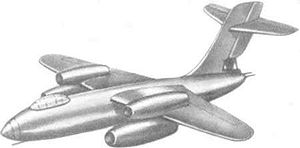Sukhoi Su-10 Video and Pictures

|
|
Sukhoi Su-10
Su-10

Picture - Drawing of Su-10 prototype
Role: Bomber
Manufacturer: Sukhoi
First flight: Did not fly
Status: Prototype only
Number built: 1
The Sukhoi Su-10 or Izdeliye Ye (Russian: Product E) was a Soviet turbojet-powered bomber built shortly after World War II.
Development
On 26th February 1946 OKB-134 was tasked with developing and building a bomber powered by four Lyul'ka TR-1A or six RD-10 turbojet engines. Work began on 24th April 1946, with many different configurations studied before the design was frozen. Alternative powerplant arrangements were constantly studied and included:-
4 x RD-10 (Jumo 004 copies)
6 x RD-10 (Jumo 004 copies)
4 x Lyul'ka TR-1
4 x Lyul'ka TR-1A
4 x Lyul'ka TR-2
4 x RD-500 (Rolls-Royce Derwent copies)
The Su-10 was a multi-engined jet bomber with a crew of four comprising, Pilot, Navigator/Bomb aimer (usually the Commander of the aircraft), gunner/radio operator, gunner/observer. Ejection seats were provided for Pilot, Navigator and radio Operator, the tail-gunner escaped after jettisoning the tail barbette.
The airframe was of all metal semi-monocoque construction with flush-riveted stressed duralumin skinning and highly stressed parts made from high strength steel. The cantilever shoulder mounted wings were trapezoidal in plan-form with rounded wing-tips. Built in one piece each wing was a two spar structure with ribs and stressed duralumin skinning, using TsAGI Sh-2-12 airfoils at the root and SR-3-12 section at the tip. The tail-unit comprised a 45 degree swept fin and un-swept tailplane at approx 2/3rds fin span using TsAGI 1V-00 aerofoil sections. Ailerons and elevators were hydraulically boosted.
Mounted at approx half span the engine nacelles were designed for minimum interference with the wing aerodynamics. The engines were arranged in vertically staggered pairs with the lower engine completely clear of the leading edge exhausting under the wing, whilst the upper engine nacelle carried over the wing exhausting at approx half chord.
Construction of test rigs and a static test fuselage was carried out throughout 1947 and the final propulsion arrangement was settled by a Council of Ministers directive on 11th March 1947, calling for the development and construction of a medium bomber powered by four Lyul'ka TR-1A turbojets. To assist take-off the Su-10 could also use four U-5 JATO boosters fitted on the lower rear fuselage sides.
The first prototype was completed and ready for flight tests when the hammer fell. Under the guise of economising on Research & Development throughout the aviation industry, many small, low output or politically disfavoured OKB's were shut in short order, all work stopping in mid stride. The complete but un-flown Su-10 was given to the Moscow Aviation Institute for use as an instructional airframe.
Specifications (Su-10)
Data from
General characteristics
Crew: Four (pilot, navigator, gunner-observer, gunner-radioman)
Length: 19.55 m (64 ft 2 in)
Wingspan: 20.60 m (67 ft 6 in)
Height: 6.56m (21ft 6-1/4in)
Wing area: 71.3 m² (767.4 ft²)
Airfoil: Root - TsAGI Sh-2-12, Tip - TsAGI SR-3-12
Empty weight: 13,435 kg (29,620 lb)
Useful load: 7,700 kg (16,980 lb)
Max takeoff weight: 21,140 kg (46,600 lb)
Powerplant: 4x— Lyul'ka TR-1A turbojets, 14.7 kN (3,305 lbf) each
Performance
Maximum speed: 850 km/h (460 kn, 530 mph) at altitude
Range: 1,500 km (810 nmi, 930 mi)
Service ceiling: 12,000 m (39,370 ft)
Rate of climb: 12.05m/s (2371.7 ft/min)
Wing loading: 297 kg/m² (60.8 lb/ft²)
Thrust/weight: 0.29
Armament
1 x 20mm Berezin B-20E cannon fixed forward firing in lower forward fuselage.
2 x 20mm Berezin B-20E cannon in a remote controlled dorsal barbette.
2 x 20mm Berezin B-20E cannon in a KG-2 remote controlled jettison-able tail barbette.
Up to 3,000 kg (6,610 lb) of bombs in the internal bomb-bay.
Comparable aircraft
Martin B-48
Convair XB-46
North American B-45
Shavrov V.B. (1994). Istoriia konstruktskii samoletov v SSSR, 1938-1950 gg. (3 izd.). Mashinostroenie. ISBN 5217004770.
Gunston,Bill (1995). Osprey Encyclopaedia of Russian Aircraft 1875-1995. Osprey. ISBN 1 85532 405 9.
Gordon,Yefim (2004). Early Soviet Jet Bombers. Midland. ISBN 1 85780 181 4.
Living Warbirds: The best warbirds DVD series.
Source: WikiPedia